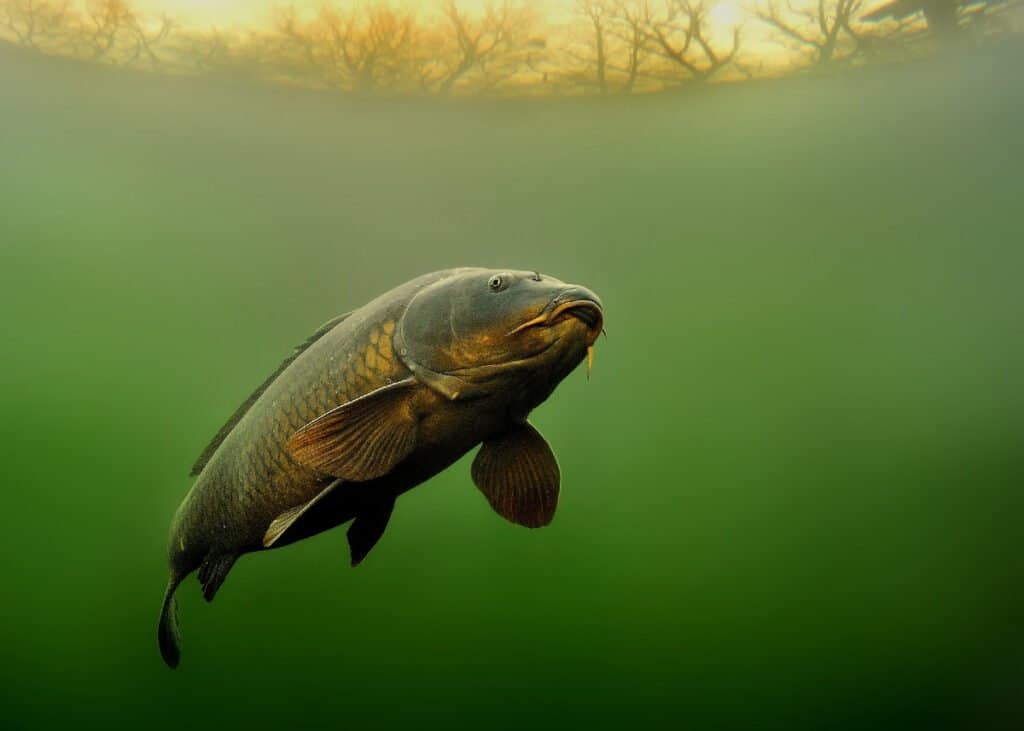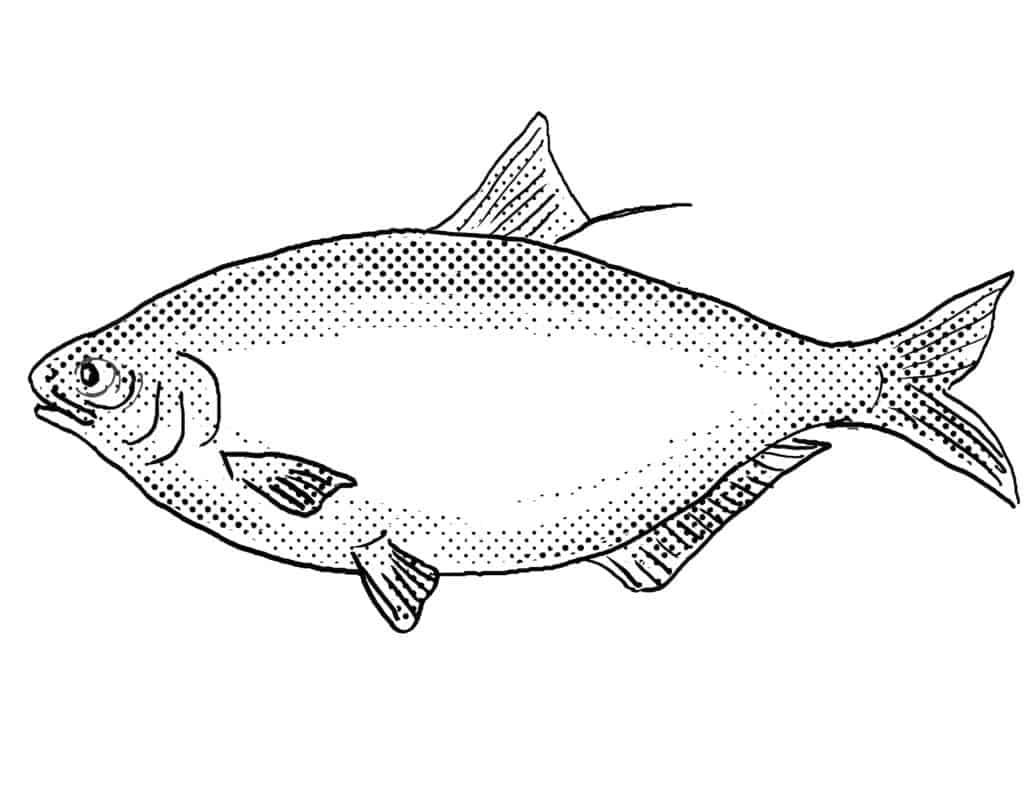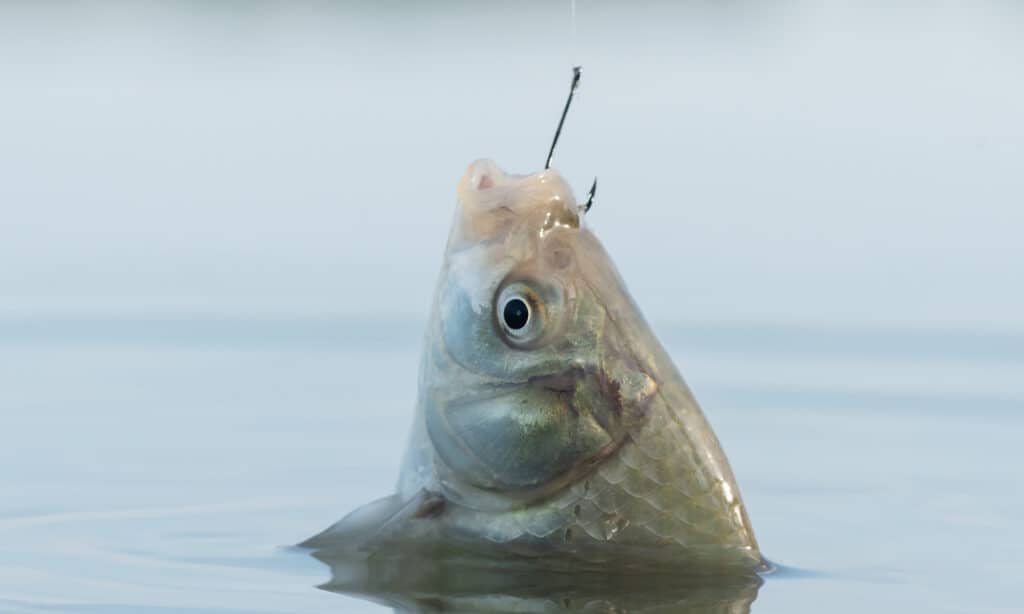Sometimes novice anglers catch a carp and think it’s a buffalo fish–It’s an easy mistake to make. Both fish have a torpedo-shaped body and a downward-shaped mouth. But they’re completely different species.
Buffalo fish are one of the 78 freshwater sucker fish species. In comparison, carp are one of the many bottom-feeding species. Their behaviors, colors, and origins are also wildly different.
Keep reading to uncover the mystery between buffalo fish vs carp.
Comparing Buffalo Fish vs Carp
Buffalo Fish vs Carp: Key Differences Explained

Martin Pelanek/Shutterstock.com
The key differences between buffalo fish and carp include their coloration, mouth shape, swimming behaviors, origins, and distribution. Carp are known for having a robust uniform color. Brown, bronze, and gold are some of the typical carp colors. Buffalo fish have a more washed-out appearance and tend to be gray, blue, or black.
Another significant difference is the presence of barbells. Buffalo fish don’t have any. Whereas carp have large whisker-like appendages called barbells, they can grow quite large.
When buffalo fish are hooked on a line, they speed away in one direction, and carp flail about. Finally, buffalo fish are native to the United States, and carp are native to Asia. To fully understand all of the differences between buffalo fish vs keep reading!
Buffalo Fish vs Carp: Coloration
Buffalo fish and carp have a similar oblong body shape but completely different colors. Carp usually have a rich bronze, brown, or gold body color. Alternatively, buffalo fish are more gray-colored and washed-out looking. There are even black buffalo fish that can be bluish or blackish colored.
Buffalo fish also have a differently colored caudal fin, also known as the tail fin. Their tail fins stand out, distinguishing them from the body’s rest. A gray buffalo fish might have a stark black tail fin.
Common carp have colors that blend in with the rest of their body. Their tails tend to be light brown, orange, or red colored.
Buffalo Fish vs Carp: Mouth Shape

patrimonio designs ltd/Shutterstock.com
Looking at a buffalo fish and carp side by side, you’ll notice that they have different mouth sizes. The buffalo’s mouth is tiny, especially if you’re looking at a smallmouth buffalo.
Usually, a buffalo fish’s mouth won’t be any more significant than the diameter of your thumb. The texture of the lips is also hard and leathery.
Anglers prefer fish that have stiff, leathery lips. When the fish fights, it’s less likely that the hook will break free.
Finally, the Buffalo fish’s mouth is turned down, as it’s a type of sucker fish. They don’t have any whiskers or barbells at the corner of their mouth.
A common carp’s mouth is much larger than a buffalo fish’s. They also have stiff, leathery lips but are not as rigid as the buffaloes. With enough of a fight, a carp can shake off the hook and free itself from even the best anglers.
Like catfish, carp have two whisker-like appendages at the corners of their mouth. These barbells can grow to be quite large.
Buffalo Fish vs Carp: Swimming Behaviors

n_defender/Shutterstock.com
When it’s time to eat, buffalo fish have it easy. Their bottom-facing mouth can suck up meals without having to angle their bodies. Carp have to angle their head downwards to find the nutrients they need.
When they’re trying to escape being eaten, carp and buffalo fish know how to put up a fight. Anglers know how tricky catching a carp or buffalo fish can be. Both fish species are robust and don’t give up easily. Considering that they can weigh over 60 lb, it can be difficult, if not impossible, for anglers to control the line.
When a buffalo fish is fighting, it usually charges in a single direction. It’ll maintain the same path, barreling ahead to get away. Buffalo fish are also known to stay below the water when they fight. They use all of their energy to distance themselves from the threat.
Common carp have a less controlled approach. After they’re hooked, they start swimming in every direction possible. A common carp will roll on the water’s surface, dive deeper, shake its head, and swim towards the threat.
Buffalo Fish vs Carp: Origins
Smallmouth, black, and big-mouth buffalo fish are native to the United States, Guatemala, Canada, and Mexico. These are the only regions where you can find and catch buffalo fish.
The species was first discovered back in 1819 by a French-born American scientist. The smallmouth buffalo discovery became Ictiobus bubalus, a Greek word meaning bullish.
Carp originate from some of the most significant rivers throughout the Asian continent. They have discovered thousands of years ago. Throughout centuries of domestication, carp have become a prime food source. They’re exported to regions worldwide. It was right around the early 20th century when the United States government began stocking rivers and lakes with carp.
Buffalo Fish vs Carp: Distribution

EB Adventure Photography/Shutterstock.com
Where could you find buffalo fish today? Throughout Minnesota, Eastern Texas, Louisiana, and Southern Oklahoma. You can also find buffalo fish throughout North Dakota and Montana. They love the muddy waters of the Mississippi River, and they’re represented in large numbers around Hudson Bay.
You can find buffalo fish throughout Canada in many extensive river systems such as the Milk River and Qu’Appelle river. They even thrive in areas that other fish would find polluted.
New studies suggest they might also have an advanced way of absorbing iron. When iron levels are dangerously high, some of the buffalo species can absorb the mineral without becoming toxic.
Alternatively, carp are all over the world. In some parts of the United States and Canada, carp are invasive. This is because the carp are so effective at eating plankton; they can outcompete some native species.
Throughout the United States, you can find and catch carp practically everywhere. However, some of their most significant populations are throughout the Great Lakes. In Canada, you’ll be able to find carp in the British Columbia and Okanagan system.
The post Buffalo Fish vs Carp appeared first on AZ Animals.
from Animal News, Facts, Rankings, and More! - AZ Animals https://ift.tt/TU8WBmE